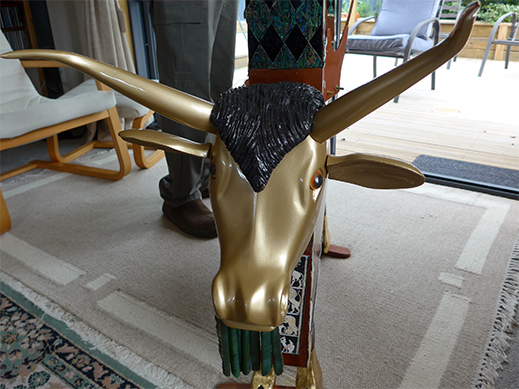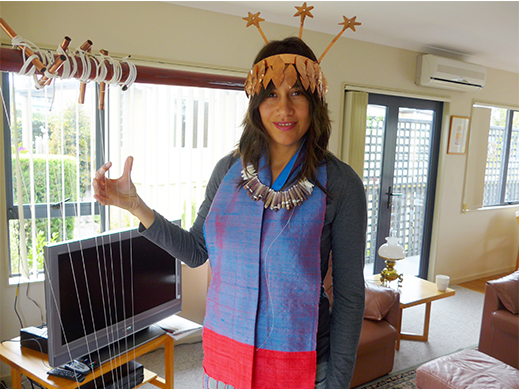The Bulls Head Lyre
In June 2013 John Knotts a local artisan and carver started a labour of love project. This was to take some 1500 hours.
The bulls head lyre (the first stringed instrument in the world) was found in a tomb in 1929. The tomb when opened revealed many gold objects and the remains of 74 retainers buried with the Queen 4,500 years ago. The harpists fingers were still on the strings when the poison they took killed them.
2003 saw the destruction of the instrument in the Baghdad museum during the occupation of American forces. John was helped by the British Museum which had completed a replica about the same time. The lyre John has constructed has a New Zealand theme using decoration of pounamu, oyster shell, pāua and obsidian. The bulls head, from heart rimu has been gilded.

The Bulls Head Lyre.
The Lyre of Tauranga
The Lyre of Tauranga was held on 2 April at the Baycourt Theatre in Tauranga, in a celebration of ancient instruments of revival and the connection of lands and cultures.
Indigenous music is based on the belief that each instrument has its own voice and its song represents the time of its creation, its place and culture of origin, and the spirituality of the musician.
The Lyre of Tauranga is the re-creation of a 4,500 year old ancient treasure, the Bull’s Lyre of Ur, the first known stringed instrument and precursor of today’s guitar. Replicated by Tauranga man John Knotts the Lyre of Tauranga is a symbol of hope and revival.
Natalia Mann is the musician performing the lyre’s song. Born in New Zealand and immersed in diverse international styles of music for most of her life, Natalia’s focus transformed from classical music to music created in collaboration with others and imbued with the voices of the instruments and their culture.
Taonga puoro are ancient Māori instruments created from natural materials and play an integral part in sacred and everyday rituals, in storytelling and other aspects of Māori life. Like the lyre, taonga puoro and their songs were thought to be lost but have experienced a revival over the past few decades.
During his studies of te reo Māori Jo’el Komene encountered taonga puoro and immersed himself in their creation, their songs and performance. A carver, Jo’el creates his own instruments and learns their songs without being taught. Completing his studies with a Masters in taonga puoro from Waikato University, Jo’el today shares his songs at marae and in workshops across the country.
Unlike classical performance there is no written notation for either the lyre nor taonga puoro. The musicians immerse themselves in the instrument’s history and culture to discover and release the instrument’s song.
The team at Baycourt Theatre offered a specialist concert venue, technical support and marketing to invite an audience to enjoy the one-off performance of the lyre and taonga puoro.
Finding a musician to perform on the lyre was no easy task, modern harps have 26 to 40 strings while the lyre has only nine. I asked Natalia Mann what attracted her to this performance. She responded:
“The most interesting aspect for me is ‘why has this cultural artefact appeared in Tauranga in the 21st century? And what on earth shall we do with it – it is so far from home.
“The poet Ileini Kabalan, a child of political refugees herself, said that it’s as if the lyre was no longer able to sing in its own home, so it has gone through the earth to other places so that its song may continue to exist. The displacement of people fleeing war is one of the great humanitarian challenges the world faces today. For me this lyre symbolises that plight.
I am excited to collaborate with Iraqi artist Sundus Abdul Hadi on this project. It is especially pertinent that Iraq has seen so many of its people displaced all over the world because of international warfare.”
To gain an understanding of the lyre’s music, Natalia has reduced the number of strings on her own instrument to nine. Natalia will have had only a few days before the performance to play the instrument, and to meet Jo’el Komene and his taonga puoro.

Natalia Mann.